Turnips can be boiled, steamed, and stir-fried. Cook turnips until they are just tender-crunchy–less than seven minutes or so for a young turnip. The flavor will be mildly sweet and crisp.
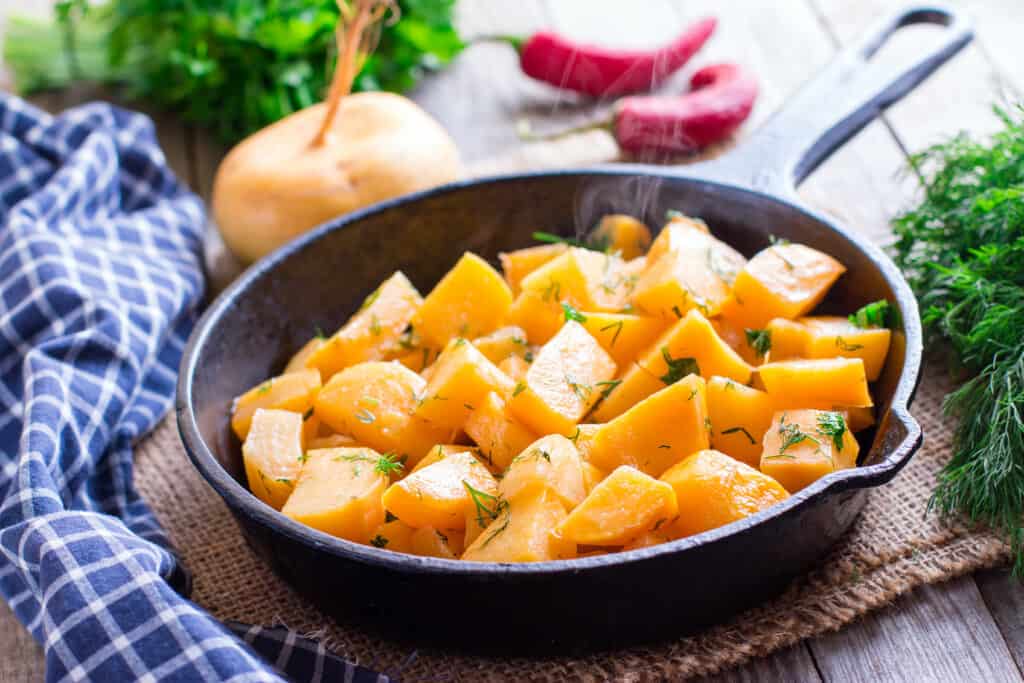
Turnips can be cooked in several ways. Roast turnips, braise turnips in butter, make turnip and potato purée, glaze turnips, or make a turnip gratin.
Small young turnips are delicate and slightly sweet; larger more mature turnips can have the crisp flavor of an apple or offer the biting flavor of cabbage, mustard, or radish.
Turnips come to harvest from mid-fall to early spring.
Kitchen Helpers from Amazon:
- Oster Vegetable Steamer
- Chef’s Knives Set of 6
- EZ Off Jar Opener for Weak Hands
- Pepper Core Remover Stainless Steel
- Kitchen Utensils – Set of 35
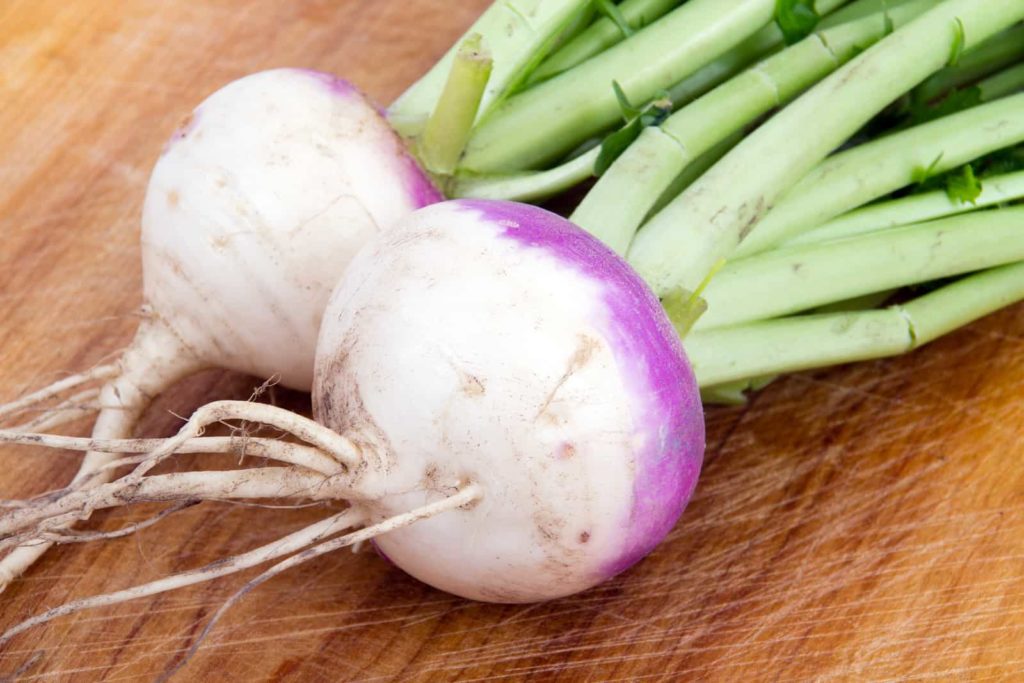
How to choose turnips
- Select turnips that are firm and heavy for their size and that are smooth and without cracks or blemishes. Avoid turnips that are oversized; they will be fibrous and bitter tasting.
- Look for turnips that are no larger than 3 inches (7.5 cm) in diameter. If the leaves are attached, they should be deep green and crisp.
- Most turnips are white-fleshed. If you cut into a turnip and it is yellow-fleshed, you probably have rutabaga. Rutabagas look somewhat like turnips but are larger, rounder, denser, and sweeter than turnips.
- There is an all-white turnip about the size of a radish that is known as a Tokyo turnip and also called Tokyo-type or kobaku-type turnip. The Tokyo turnip has a delicate, buttery flavor.
How to store turnips
- Select turnips that are firm and heavy for their size and that are smooth and without cracks or blemishes. A
- Store them in the refrigerator in a perforated plastic bag for 1 to 3 weeks.
- Turnip leaves or greens should be removed and stored separately in a perforated plastic bag.
- Turnip greens will keep for 4 or 5 days in the refrigerator. To freeze turnips, first, blanch them for a couple of minutes or cook them and then purée.
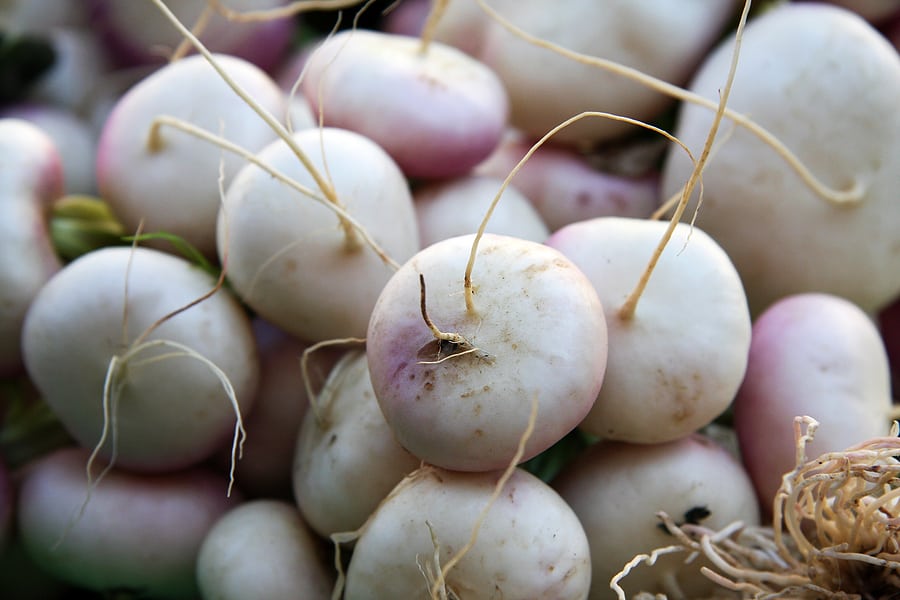
How to prepare turnips for cooking
- Before using, wash turnips in cool water, trim the top and bottom, and peel if necessary. Young turnips do not need to be peeled, but older turnips will have tough skin that is best removed.
- Turnips take longer than carrots to cook; allow 10-15 minutes when boiling, slightly more when steaming.
- Turnips absorb fat easily so fried turnips will be high in calories.
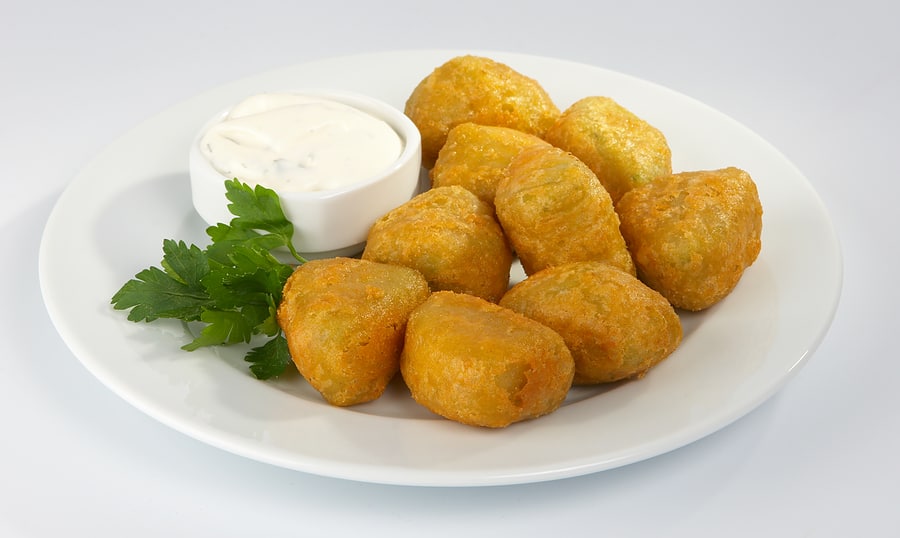
How to bake turnips
- Preheat the oven to 400 degrees F.
- Rub the turnip with olive or vegetable oil; sprinkle it with salt. Prick the turnip with the tines of a fork.
- Place the turnip on a baking sheet or lay it directly on the oven rack,
- Bake for 45 to 60 minutes (depending on size); turn the tuber once at halfway.
- Bake until the skin is golden and crispy; the turnip will be baked when a sharp knife inserted in the flesh meets no resistance. The internal temperature should be about 210 degrees F.
How to roast turnips
- Roast turnips with the skin on or peeled. Cut large turnips into thick wedges.
- Precook cut turnips in a microwave until soft but still firm, about 4 minutes. Or boil in salted water until tender, about 10 minutes.
- Preheat the oven to 450 degrees F.
- Spread the wedges on a pan or baking sheet and drizzle with olive oil or fat and toss well. The pieces should be evenly coated and the pan should have light, even oil across the surface.
- Season with salt, dry herbs, or spices.
- Roast 20 to 30 minutes, until bottoms are browned and a spatula slides under them smoothly.
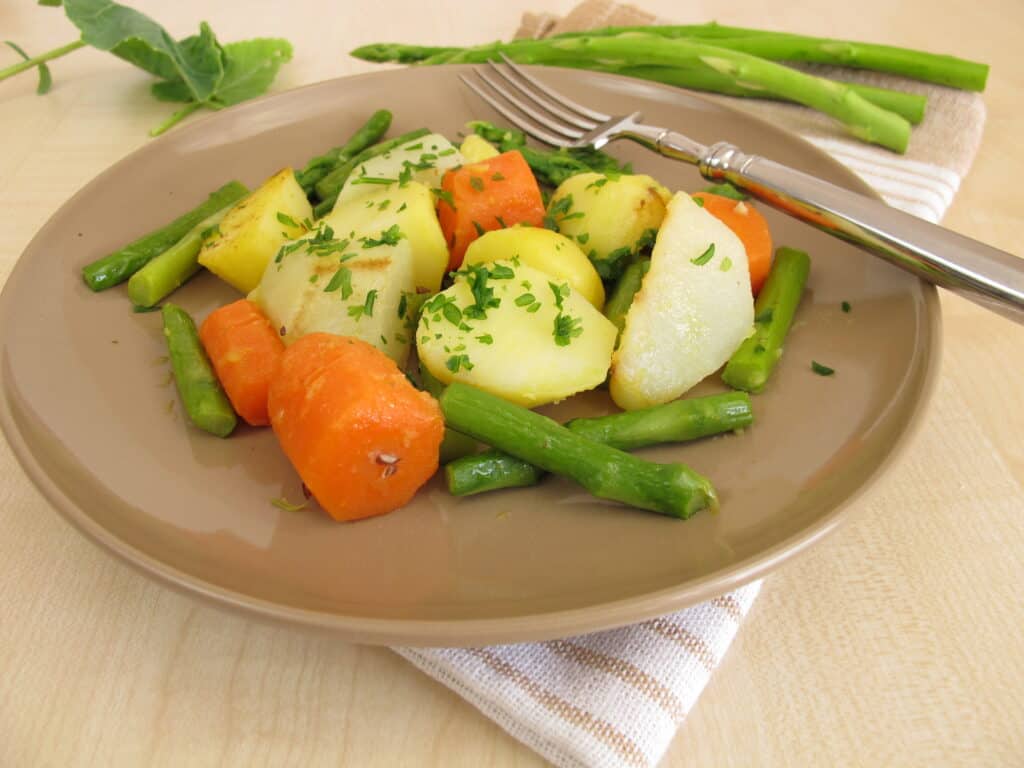
How to boil turnips
- Peel and trim the turnip.
- Cook whole or cut the turnip into roughly equal size pieces, 1 or 2 inches in diameter.
- Place a whole or sliced turnip in a pot with water to cover and add a pinch of salt, or put in a steamer above the water.
- Add a teaspoon of sugar to give it a bit of a sweet taste.
- Bring to a boil and cook until the turnips are tender; about 10 minutes for cut pieces, and about 35 minutes to cook whole.
How to microwave turnips
- Place the whole or sliced turnip in a covered dish.
- Sprinkle it with a bit of water.
- Cook in the microwave on high for about 10 minutes.
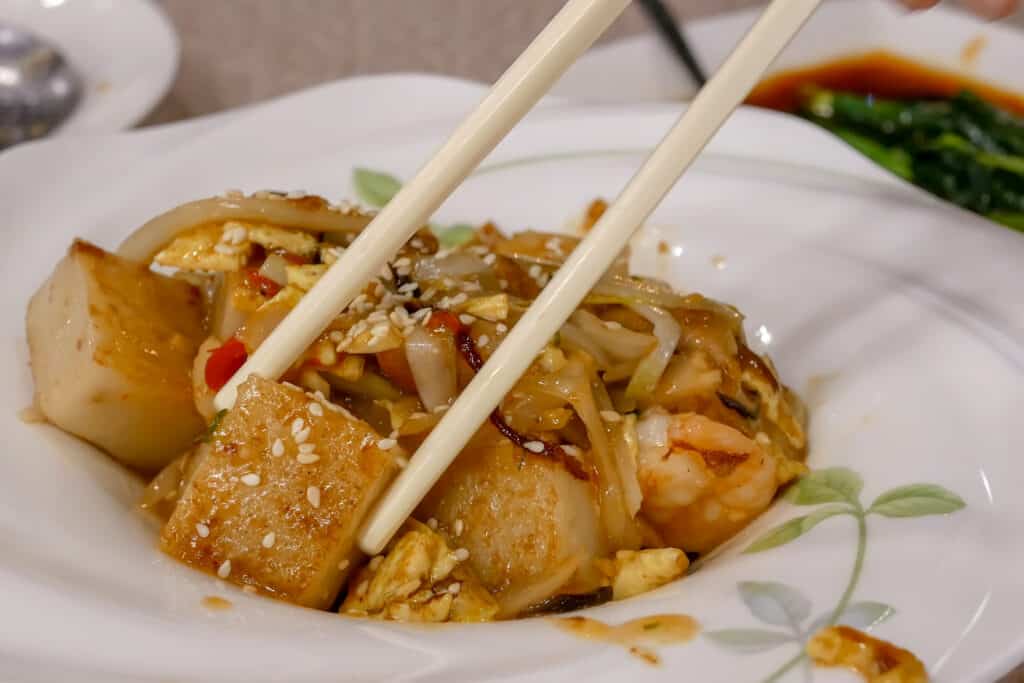
How to stir-fry turnips
- Peel and trim the turnips.
- Slice the turnips into thin strips; the smaller the pieces the faster they will cook.
- Heat 2 tablespoons of corn oil in a large, deep skillet over medium-high heat for 3 or 4 minutes.
- Add the turnip and a quarter cup of stock or water.
- Cook, stirring constantly, until the turnip is tender, about 7 minutes.
How to mash turnips
- Cut or dice turnips into pieces and place them in a pot. Cover them with water and add a dash of salt.
- Bring the water to a boil.
- Lower the heat and let it simmer until the pieces are tender, for 15 to 40 minutes depending on the size of the pieces.
- Drain the turnips and mash the pieces with a potato masher.
- Work in 4 to 6 tablespoons of melted butter and season to taste with salt and pepper or a pinch of powdered nutmeg or cinnamon.
Mashed Turnips and Russet Potatoes
Yield 4-6 servings
Instructions
- Trim and peel 8 or 9 medium-size turnips and cut into bite-size cubes. Place in a large saucepan with lightly salted water to cover and simmer until just tender–that is pierced with a sharp knife, about 25 minutes.
- Add 3 medium russet potatoes peeled and cut into bite-size cubes and continue cooking until very tender, about 15 more minutes.
- Drain the saucepan and mash the turnips and potatoes with a potato-masher or pass through a food mill into a large bowl. Add 4 tablespoons of unsalted butter and salt and pepper to taste. Whisk in 3 tablespoons of sour cream.
- Return puree to saucepan and cook over low heat for 2 to 3 minutes, stirring constantly, until the puree thickens.
- Garnish or fold in 3 tablespoons of minced fresh chives and serve hot.
Notes
This dish can be served with roast or meatloaf.
Courses Side Dish
How to make turnip fries
- Cut turnips into spears or strips.
- Toss spears in olive oil along with salt and seasonings of your choice–garlic powder, dried thyme, or cayenne.
- Place spears on a baking sheet or roasting pan and roast at 425 degrees F for 30 minutes.
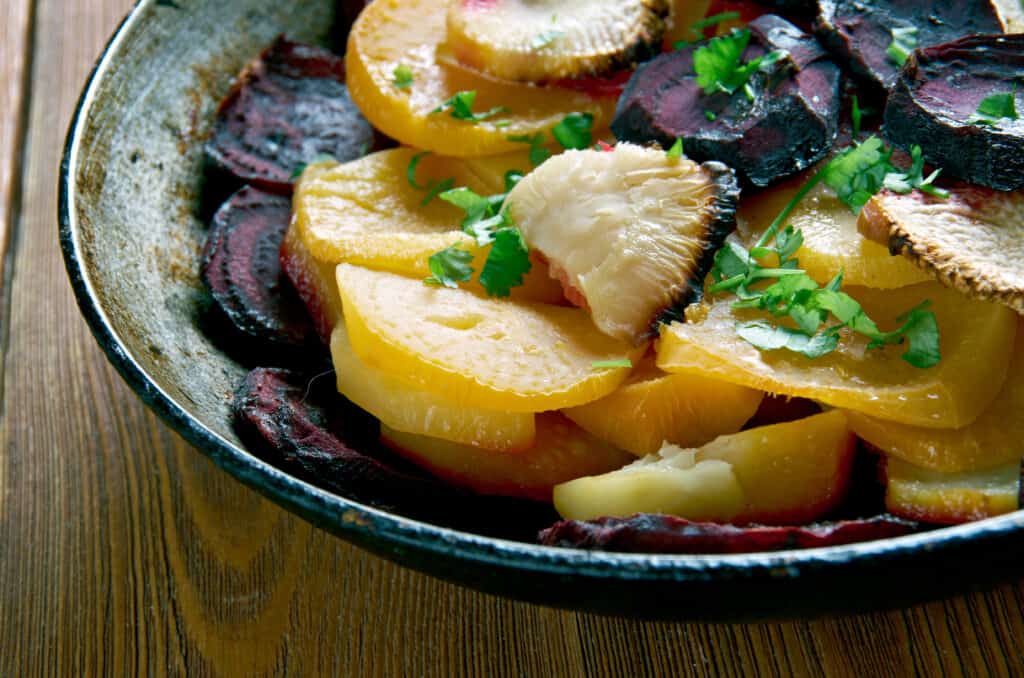
How to make turnip gratin
- Preheat the oven to 400 degrees F.
- Peel the turnips and slice them up to 1/4-inch thick.
- Layer the slices in an ovenproof skillet almost to the top. Overlap the slices slightly nearly to the top of the skillet.
- Dot the top of the slices with 2 to 3 tablespoons of butter, and cut them into chunks. Pour in half-and-half (or a combination of milk and cream) to come 3/4 of the way to the top (about 2 to 3 cups).
- Place the skillet on the stove and bring the liquid to a boil; reduce the heat and cook for 10 minutes, until the liquid level drops.
- Place the skillet in the oven and bake until the top browns, 10 minutes.
- Reduce the heat to 300 degrees F and garnish the top with grated cheese (Cheddar, Gruyère, Parmesan). Cook 10 minutes more or until tender and browned.
How to prepare Tokyo turnips
The Tokyo turnip is a diminutive, small radish-sized turnip with a crunchy, juicy bittersweet flavor eaten raw. Steamed it is buttery-sweet and delicate.
You will find the Tokyo turnip in early spring. You might mistake it for a white radish if you don’t look closely enough. The Tokyo turnip is white through and through.
Tokyo turnips are most often harvested at 1 to 3 inches (2.5-7.6 cm) in diameter. They will be globe shaped and perhaps slightly flattened. About 8 to 12 of these pearly turnips make a pound. Look for them still attached to fresh greens.
The Japanese call these turnips kabura-type turnips, varieties include ‘Tokyo White’, ‘Tokyo Market’, and ‘Tokyo Cross’. In markets outside of Japan, all are usually simply called Tokyo turnips or white turnips.
Serve. Serve these turnips sliced with crisp sea salt. (Try the French “fleur de sel” or “flower of salt”, a hand-harvested sea salt).
Steam. Steamed Tokyo turnips are nearly a delicacy. Choose turnips of equal size and wash them thoroughly under running water or soak them until any grit or sand falls away. You don’t need to remove the greens; you can actually use them as a bed for steaming.
Spread the turnips with greens attached on a steamer rack over boiling water, cover, and cook until just barely tender, about 3 to 6 minutes depending upon the size of the turnips. (Choose turnips of equal size for even steaming of the bunch.)
When tender, drain the turnips and greens on a kitchen towel and serve with a side dish of salt or butter or pepper, or all three. Steaming turnips of any type will bring out the best flavor.
Flavor partners. Tokyo turnips can also be pickled, roasted, sautéed, or boiled in soups. You can use them as a garnish or serve them alongside poached or grilled whole fish or roasted meat. Served raw Tokyo turnips are good with a vegetable dip or you can throw them into a salad sliced or whole.
How to prepare Gold Ball turnips
The Gold Ball Turnip has been long noted for its flavor, slightly sweet and smooth with an aftertaste of almond.
The late fall harvest particularly favors the Gold Ball which like most good-tasting turnips comes to maturity during the times of the year when the outside temperatures tend to stay uniformly cool. That’s fall and spring. (Summer heat can make almost all turnips tough and bitter tasting.)
As its name suggests, the Gold Ball has golden-yellow skin and flesh. At maturity, it is about the size of a small ball, not more than 6 inches (15 cm) in diameter. Like all turnips, if harvested at half its mature size, it will be the most mellow tasting.
The exact origin of the Gold Ball is unclear, but it is an old-time variety that dates back at least to the early 19th century in Scotland and the North of England. It was registered in the United States patent office in 1855 as Robertson’s Gold Ball.
Turnips, in general, have been in cultivation for more than 4,000 years and probably originated in the Near East. The Greeks and Romans were known to have developed several varieties. Besides the root, turnip leaves can be eaten much like spinach.
Choose. If you want the best-tasting turnips, select small turnips—no bigger than 3 inches (7.5 cm) in diameter–with unblemished skin and fresh, green leaves. The flesh of larger turnips can be woody. A turnip should feel heavy for its size.
Store. Turnips can be kept in the refrigerator in a plastic bag for up to 1 week.
Serve raw. Raw turnips can be shredded with cabbage and carrots and served with a sharp mustard vinaigrette. Young turnips can be sliced raw and added to salads or served as substitutes for radishes.
Cook. Steamed and boiled turnips can be served with butter or cream. You can add sugar to the water to improve the flavor. You should allow 10 to 15 minutes when boiling turnips and slightly longer when steaming them.
Pair Gold Ball turnips with carrots. The taste is excellent.
More ways to prepare turnips
- Turnips can be eaten raw, baked, boiled, or mashed. Prepare turnips as you would carrots.
- Toss steamed small turnips with butter and parsley and serve. Boiled turnips can be mashed with butter and cream or puréed for soup.
- Sliced or grated raw turnips make a tasty addition to salads.
- Small turnips can be used as a substitute for radishes. Steamed or boiled turnips can be served with butter or cream.
- Turnips can be used in soups or stews or cooked around a roast.
- You can slice or julienne raw young turnips to add a crisp, crunch to salads.
- The French harvest turnips early when they are still young and braise or fry and glaze them.
- Serve slices of raw young turnips with olives and cherry tomatoes to make a simple appetizer.
- Shave raw turnips, crisp them in iced water, sprinkle with salt, and serve as you would radishes on an appetizer tray.
- Thin slice turnips and serve like chips with dip.
- Grate raw turnips with cabbage, carrots, and onion and toss with mustard vinaigrette.
- Cook small turnips and their greens separately until tender then serve with crumbled bacon on top.
- Bake young turnips with grated cheese or served with a cream or Mornay sauce.
- Stir-fry shredded turnips with scallions and other vegetables.
- Mash cooked turnips like you would potatoes; serve like potatoes or mash them with potatoes.
- For scalloped turnips: layer thin turnip slices with sliced onion; place butter on each layer and sprinkle with flour and salt. Pour in a cup of beef broth and bake for 90 minutes at 350°F.
- Dice raw turnips into ¼-inch cubes; cook in a heavy saucepan with a tight-fitting cover for 10 to 15 minutes until tender cooking in butter and water—2 tablespoons of butter and 4 or water to 2 cups of diced turnips. Salt and add sugar to smooth any bitter taste.
- For creamed turnips, follow the steps above with the further step of adding cream blended with a little flour and a sprinkling of chopped chives and parsley.
- Serve creamed or sour-creamed turnips with chopped beef, steak, baked ham, or roasted turkey.
How to cook turnip greens
Turnip greens can be strong-flavored. You’ll want to cook them before serving: boil, braise, sauté, steam, or stir-fry. The strong flavor is muted when cooked with other, milder greens.
Turnip flavor partners
- Turnips have a flavor affinity for cream, curry, duck, lamb, lemon, marjoram, onions, pork, potatoes, thyme, and vinegar.
Turnip nutrition
One-half cup of turnips contains just 23 calories. Turnips contain vitamin C and turnips greens are rich in vitamin A.
- Turnips are a good source of vitamin C and potassium and contain folic acid.
- Turnips contain sulfur and may cause flatulence.
 Get to know turnips
Get to know turnips
- The turnip is round and squat and looks like an old-fashioned spinning top with a rosette of bright green leaves growing from the top. The upper portion of the turnip’s slightly flattened orb is lilac-purple and the bottom half is white. Young turnips can be radish sized; mature turnips can be as big as a large orange or bigger.
- The turnip is not actually a root but a swollen stem base. The ancient Romans distinguished between at least two types of turnips: one called rapa whose stem was large and round, like present-day turnips; a second, called napus whose stem was slender and pointed.
- The turnip has been cultivated for at least 4,000 years and is believed to have originated in Northern Europe. During the Middle Ages, turnips were known by the name nepe (from the Latin napus). Nepe was combined with “turn”–as to “make round”–to become turnip.
- Turnips were introduced into China by traders about 2,000 years ago. From China, turnips were introduced to Japan about 1,300 years ago.
The botanical name for the turnip is Brassica rapa var. rapa
Turnip articles on Harvest to Table:
How to Harvest and Store Turnips
Eight Ways to Cook and Serve Turnips
Three Ways to Cook Turnip Greens
Turnip, Rutabaga, and Kohlrabi Growing Problems Troubleshooting
Also of interest:
How to Harvest and Store Turnips
Articles of interest:
Best Herbs for Container Growing
Garden Planning Books at Amazon:
- Vegetable Garden Almanac & Planner
- Kitchen Garden Grower’s Guide Vegetable Encyclopedia
- Vegetable Garden Grower’s Guide
- Tomato Grower’s Answer Book
More kitchen tips:
Bring your harvest to the table. Kitchen prep tips and easy recipes for the vegetables you grow. Click below for vegetable prep and recipes you can use now.
- Almonds
- Apples
- Apricot
- Aprium
- Artichoke
- Arugula
- Asparagus
- Avocado
- Bamboo Shoots
- Banana
- Basil
- Beans, Dried
- Beans. Long
- Beans, Shell
- Beans, Snap
- Beets
- Bitter Melon
- Blackberry
- Bok Choy
- Broccoli
- Broccoli Raab
- Brussels Sprouts
- Cabbage
- Cardoon
- Carrots
- Cauliflower
- Celeriac
- Celery
- Chard
- Chayote Squash
- Cherimoya
- Cherries
- Chestnut
- Chickpea
- Chinese Cabbage
- Chives
- Cilantro
- Citron
- Clementine
- Collards
- Coriander
- Corn, Sweet
- Corn, Baby
- Corn Salad, Mache
- Cranberry
- Cress
- Cucumber
- Daikon
- Dandelion
- Dill
- Eggplant
- Endive, Belgian
- Endive and Escarole
- Fava Beans
- Fig
- Florence Fennel
- Garlic
- Ginger
- Grapefruit
- Grapes
- Guava
- Horseradish
- Jerusalem Artichoke
- Jicama
- Jujube
- Kale
- Kiwifruit
- Kohlrabi
- Kumquat
- Leeks
- Lemongrass
- Lemons
- Lettuce
- Lime
- Mache (Corn Salad)
- Mandarin Orange
- Mango
- Maple Syrup
- Marjoram
- Melons
- Michihili
- Mint
- Mizuna
- Mushrooms
- Mushrooms, Cremini
- Mustard Greens
- Napa Cabbage
- Nectarine
- Okra
- Olives
- Olive oil
- Onions
- Oranges
- Oregano
- Parsley
- Parsley Root
- Parsnips
- Passion Fruit
- Pawpaw
- Peaches
- Pears
- Peas, Garden Snap
- Peas, Snow
- Pei Tsai
- Peppers, Chili
- Peppers, Sweet
- Persimmon
- Pineapple
- Pineapple Guava
- Plantain
- Plums
- Pluots
- Pomegranate
- Potatoes
- Prickly Pear
- Pumpkin
- Quince
- Radicchio
- Radishes
- Raspberries
- Rosemary
- Rhubarb
- Rutabaga
- Sage
- Salsify
- Sauerkraut
- Savory
- Shallots
- Sorrel
- Spinach
- Squash, Summer
- Squash, Winter
- Strawberries
- Sunchokes
- Sunflower
- Sweet Potato
- Swiss Chard
- Tangerine
- Taro
- Tarragon
- Thyme
- Tomatillo
- Tomato
- Turnip
- Turnip Greens
- Yams


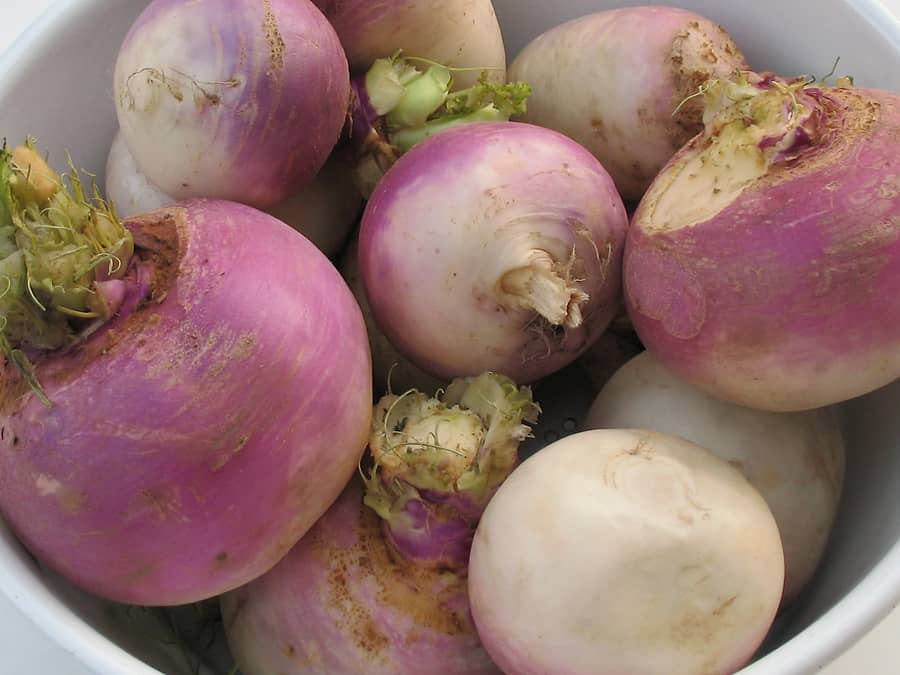 Get to know turnips
Get to know turnips












